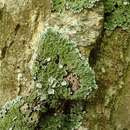fr
noms dans le fil d’Ariane


Upper Surface: K-, pruinose at least near tips, occ. with tiny cortical hairs
Lower Surface: corticate, generally dark at least near center in age, prosoplectenchymatous, squarrose rhizines (or at least mostly branched)
Algae: green (trebouxioid)
Reproduction: apothecia, soredia, or isidia
Spores: physcioid (Physconia-type)
Worldwide, but mostly temperate to boreal.
Common name: Frost Lichens
Family: Physciaceae
Relatively small or narrow-lobed foliose lichens, typically some shade of gray or brownish and pruinose.
Found on all types of substrates.
No other physcioid genera have squarrose rhizines, however there are one or two species with merely forked or even mostly simple rhizines. In such cases use the following differences to rule out other genera:
Anaptychia: upper cortex prosoplectenchymatous (instead of paraplectenchymatous or scleroplectenchymatous)
Physciella: never pruinose, lower surface always pale, spores Physcia or Pachysporaria-type
Phaeophyscia: never pruinose, lower cortex paraplectenchymatous
Heterodermia and Physcia: cortex K+ yellow (atranorin)
Parmeliaceae: shiny at least near growing tips, typically much larger, spores totally different
Physconia is a genus of lichen-forming fungi in the family Physciaceae. It has about 25 species.[1] The genus was circumscribed by Czech lichenologist Josef Poelt in 1965, with Physconia pulverulenta assigned as the type species.[2]
Physconia is a genus of lichen-forming fungi in the family Physciaceae. It has about 25 species. The genus was circumscribed by Czech lichenologist Josef Poelt in 1965, with Physconia pulverulenta assigned as the type species.
Physconia Poelt (soreniec) – rodzaj grzybów z rodziny obrostowatych (Physciaceae)[1]. Ze względu na współżycie z glonami zaliczany jest do porostów[2].
Pozycja w klasyfikacji według Index Fungorum: Physciaceae, Teloschistales, Lecanoromycetidae, Lecanoromycetes, Pezizomycotina, Ascomycota, Fungi[1].
Polska nazwa według W. Fałtynowicza[2].
Nazwy naukowe na podstawie Index Fungorum[4]. Nazwy polskie według W. Fałtynowicza[2].
Physconia Poelt (soreniec) – rodzaj grzybów z rodziny obrostowatych (Physciaceae). Ze względu na współżycie z glonami zaliczany jest do porostów.